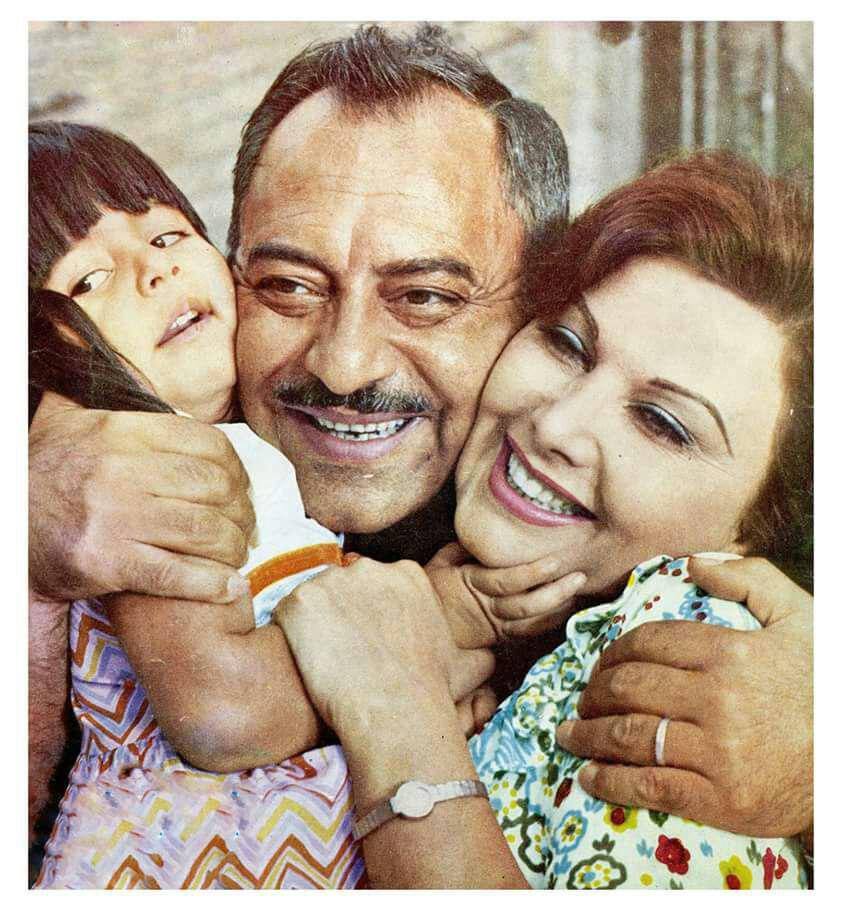
By Ramin S. Khanjani.
Of all directors associated with the pre-1979 “Iranian New Wave,” Nosratallah Karimi probably presents one odd case for study. With the inconsistent critical reception of the films he has to his credit as an actor and director,[1] Karimi is classified as belonging to a borderline sub-group of New Wave directors labelled as the “Third Movement.” This category has been designated in recent years by Iranian film scholars in an attempt to set apart films made by this group of filmmakers from the more artistically aspiring and less commercially blemished films of the New Wave. Whether seen in this smaller sub-category or studied together within the broader framework of the Iranian New Wave, Karimi’s oeuvre strikes a note of discordance, not least owing to its fundamental and profound element of comedy.
By and large, films belonging to the Iranian New Wave have been characterised by a bleak view of society nurtured by the filmmakers’ bellicose stand towards all-out modernisation, which, as history testified, was mostly taking place on the surface. Sharing with those films a concern about the clash between traditional and modern lifestyles and values, and even premised around this core concept, Karimi’s films totally eschew the sepulchral air of New Wave films and wrap their, yet equally critical, content in a layer of comedy (a genre that didn’t appeal much to his serious-minded colleagues). This holds true of Karimi’s most acclaimed film, The Carriage Driver (1971), which as a directorial feature debut set the bar too high for him to leap over, and its affinity with the New Wave films otherwise is not usually contended.[2] In fact with less critical appreciation conferred upon the films that followed this celebrated debut, Karimi is generally portrayed within Iranian film history as another filmmaker with a “flash in the pan” career.
Karimi’s career as a live action feature director remained limited almost entirely to a few years in the 1970s, while his later output – from the 1980s and early 90s – includes a filmed version of his own puppet theatre, a puppet short animation, a puppet series for a private TV station and a number of TV ads, again making use of puppets. Most of this work was uncredited. Karimi’s unofficial banishment from the territory of feature filmmaking is mainly the consequence of his controversial second outing, The Interim Husband (1971) which dared to tread the minefield of religious beliefs. Though by no means critical of the core values of Islam, the film’s humorous take on one sharia law sparked furore amongst some clerics and it courted infamy as a comedy deriding the religion. The film is often cited by Islamic hardliners – in their biased and distorted renditions of the history of Iranian cinema – as the prime manifestation of anti-Islamic cultural policies pursued by the royal regime.[3] The director even had to go through a short stint of incarceration, followed by his name being almost erased from the screen (his activities in puppetry and animation could still be made public, although not often touted under his own name).

Not blessed with the same degree of critical acclaim as Karimi’s first film, The Interim Husband is still viewed as one of the products of its time that stood well above the commercial fare (in Massoud Mehrabi’s History of Iranian Cinema, which for its most part only discusses a few selected movies from each year, The Interim Husband is one of the few titles that makes the cut for its year of production). However note must be taken that the anti-religious brand attached to the film has almost hushed up any serious discussion and re-evaluation of this film within Iranian film scholarship inside the country. From a mere social standpoint The Interim Husband also constitutes by far a more interesting case than The Carriage Driver, given the repercussions of its screening as well as the sea changes in social life which ensued some years later. Showing a bigger consideration for the box-office than the more balanced The Carriage Driver, The Interim Husband also makes a good case for studying how Iranian filmmakers of the period tend to steer off into the terrain of commercialism. This could be effectively accomplished by examining the film together with Karimi’s third feature film The Triple Bed (1972), which presents commonalities with The Interim Husband, yet has been almost totally dismissed by the critics as artistic flop, while also failing to repeat the box office success of his two earlier films.[4] Considering the theme and the characters, these two films – The Interim Husband and The Triple Bed – in fact stand out as a distinct pair in the director’s career and thus lend themselves to such a paired mode of study.
Even if considered aesthetically spotty by critics, the directorial output of Karimi is categorically unified with similar themes and concerns that comfortably earn him the position of an “auteur,” for what it is worth. Karimi’s films are rife with marks of a traditional lifestyle, visible in the images and locations or transpiring through characters’ actions and articulated opinions. In that regard, Karimi’s approach boasts its distinction by virtue of focusing on the more intimate aspects of the traditional life which tended to be protected from the gaze of the camera. Though intimacy, especially around the time Karimi made his films, was not extraneous to Iranian cinema, it often surfaced in the context of fictive worlds stemming from the rock-bottom escapism of Iranian commercial cinema (a.k.a. filmfarsi). Karimi’s films – in particular his first two feature films – show stronger affinity with some forms of neorealism.[5] Doubtless, such a link can be chalked up to Karimi’s background of training in Italy, including assistantship to Vittorio De Sica, whom Karimi fondly remembers as a mentor, especially with regards to working with non-actors, as well as to his engagement with the practice of dubbing foreign films into Farsi in Italy (including a good number of Italian pictures of the period). The continuity between the latter and Karimi’s later filmmaking cannot be easily overlooked. In dubbing films into Farsi, a trend gradually emerged among the Iranian voice-artists to avoid formal language and spice up the translated dialogues with Farsi slang expressions and impromptu comic asides, to make films further delectable, so to speak, for the target audience (Zhirafar 2013: 158). It can be claimed that Karimi’s comedies have been cultivated by a comparable notion; while looking back on some general principles of Italian neo-realism, these films are firmly grounded in their local culture and as such exuded a remarkable local appeal. That is to say, Karimi pursued the underlying notion of neorealism to turn his camera toward the real people and their antics, while in doing so he yoked it to an element of traditional and popular Iranian theatre with which he was conversant.[6] As a matter of fact, Karimi himself didn’t view neo-realism as the proprietary school of Italian cinema. According to him, Italian neo-realists defined their school as “nationally imbued realism” and therefore the result of such a pursuit inexorably acquires national and local specificity (Omid 1998: 582).[7]
The titles of Karimi’s two domestically intimate comedies of our discussion – The Interim Husband and The Triple Bed – are transparent enough as to their slightly ribald contents, even though the title for the latter was mandated by the producer to ensure a better box-office (Ansari 2008: 110). As deviating forms of the typical elements of matrimony – “husband” and “bed” – the titles of both films invoke the notion of an aberrant family life, especially to a non-Iranian spectator with little or no knowledge of the traditions the films address. One of course should not discount the fact that critics’ reservations about these two films at least partly resulted from their sanctimonious oversensitivity to the salacious quality of the films, which in all fairness later became a bane of commercial cinema. (For instance, Jamal Omid in his history of Iranian cinema celebrates Ruined (Khane-kharab, 1975), Karimi’s fourth and final feature film, which avoids sexually charged themes, as a return to “a respectable cinema that delivers a message” (1998: 695), while Masoud Mehrabi disparagingly speaks of The Interim Husband as the trailblazer of Iranian films pivoting on nether-organ affairs, so to speak (1987: 142).

Titled Mohallel in Farsi, Karimi’s second feature film refers to one Islamic (sharia) law governing divorce. The law concerns a special type of divorce, known as “se-talaghe” (literal translation: triple-divorce or three-time divorce) which once issued prohibits a man from “returning” to his divorced wife and marrying her again, unless in the interim she gets married to another man and, regardless of the duration of their relationship, has been bedded at least once. This is a practice which, as transpires in the film’s dialogue, had been outlawed at the time it was shot, because of being in conflict with enforced civil law; yet it continued to survive surreptitiously among the traditional echelon of Iranian society, whose social values have profoundly been derived from religion. The film takes its title from the name for a man who, through marrying the divorcee, provides “a solution” to the process of reunion and renders the divorced wife once again “halal”and thus accessible to her (former and future) husband.[8] This religious law turns into an apt tool in the hands of the writer-director to take the measure of the tensions stirred up in a patriarchal society, when one of the rules stemming from its underlying precepts (i.e. religion) stops functioning in favour of the privileged members of that society and instead turns into an agonising thorn in their side, compelling them to part with their most boasted and inviolable “masculine honour” (the most valuable asset of a man in those societies, over protection of which blood could be easily shed).
More than a heretic critique of a religious minor law, The Interim Husband operates as a mockery of this bloated masculine honour, upholding of which persisted and then thrived on under the forthcoming religious regime of Iran. The central character of the film is a traditional guy and an observant follower of religious rules. This inculcated mentality, complete with an overbearing sense of jealousy, have brought him to enforce limiting rules of modesty upon the female members of his household. Following an incident that makes him imagine infidelity on the part of his wife, he flies into an implacable rage and after an episode of commotion divorces his wife. Later, when the truth is evinced and the hangdog man comes back to be reunited with his wife, another horrifying truth downs on him. Blinded by rage, he’d asked for the – clandestinely practised – “triple-divorce.” Though these divorce terms are illegal, the man’s deep religious bounds pre-empts disregarding it and he has to cave in to this most dreaded and embarrassing option of finding an interim husband. So begins the man’s adversities to survive through this episode of shame and find the right, most “harmless” interim husband who holds the key for him to legitimately remarry his wife. The incident, nonetheless, presents itself as a boon to the old suitor of his wife – also their neighbour – to finally indulge his desire and mete out his revenge against his old rival. To further complicate matters the neighbour’s son is in love with the hapless man’s daughter (and in fact their discreet tryst touched off the entire incident).
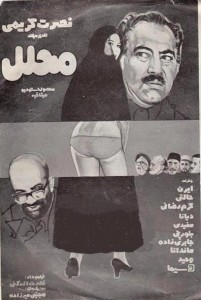
At least one poster for The Interim Husband matches the notoriety surrounding the film, yet crystallises the worldview upon which the plot rests. Depicted in the poster in question is a feminine figure wrapped in a chador – a traditional piece of clothing supposed to cover the woman from head to toe, allowing only the face, or parts of it, to be visible to strange men – but as if the chador is erased by an invisible hand, the middle part of the woman is exposed, revealing a sexy feminine body in lingerie. In common with Iranian commercial films of the period and their ad campaigns, the poster lewdly amplifies the lure of sex, yet at the same time it offers a straightforward figuration of the main character’s view of woman, as an object for sex but one that must also be enshrouded and protected in the most rigorous way from other similarly lustful men.
Haji Ala, the main male character of The Interim Husband, who epitomises such ambivalent expectations, seems to belong to one of the most traditional strata of society which is allied the strongest to the religion. A small business-owner, as it seems, he feels no obligation to conform to the modernisation of lifestyle as advocated by the West-aligned government of the time. Even the technological devices are allowed in his household only as long as they don’t pose any threat to his straitlaced life style (the radio, for instance, is only permitted as a tool to inform him of the time for prayers and only in his absence his young son dares to use it for listening to music). The title of “haji” by which he is addressed acquires further resonance in this respect. Referring to this title, a recent reading of the film have even gone as far as to see the film as a prognosticator of years to come and the main character as the representative of the social class which usurped and controlled power in the aftermath of the 1979 revolution through their mutual bonds with clerics (Ahmadi 2015). Yet this title can also illuminate a direct influence from the traditional Iranian comedy theatre known as roo-howzi. In these theatre comedies which usually takes place in a household and involves its inhabitants, “Haji” – an honorific used to address people who have been to Mecca on pilgrimage and fulfilled their religious duty, and common among many middle-aged and older small business owners – is a main character who represents the head of a traditional family. Among the other fixtures of these comedies there is also Haji’s servant, usually embodied in a character known as Siah (“black”) and played by an actor with a sooted face to match his appellation. Early on, Iranian cinema recruited the stock-character of Haji to illustrate the clash of values and generational rifts that started to become commonplace. The fanatic eponymous protagonist of Ovanes Oganians’ silent film, Haji Agha, the Movie Actor (1933) is the cinematic progenitor of all likeminded personages to come, even though by the end of the film he emerged as a “reformed” character in the spirit of acknowledging the efficiency of the state-orchestrated social and cultural changes of the era. Unlike Haji Agha of Oganians’ film and similar characters patterned after the same stock character, Haji Ala doesn’t strike us as a traditional one by his mere appearance. He doesn’t even grow a beard or visible stubble as expected from one conforming to a traditional interpretation of religious rules. In this upgraded embodiment and despite all his ramblings, “Haji” looks even more fragile and vulnerable to those he is purporting to have under his thumb, the women.
The Interim Husband is an erotic film to the core, even if the eroticism doesn’t run too much explicitly in its visual content. All the same, the sexual discourse dominates and steers its narrative, even more so than The Triple Bed, which by its title alone tries to sell itself off as a sex comedy. Furthermore, sex in The Interim Husband parlays into an avenue for self-assertion, resistance and defiance – if not an all-out mutiny in the manner of, say, Ali Hatmai’s Ghalandar (1972) – for capitulated and enchained femininity. Considering Karimi’s presentation of patriarchal culture’s double-edged ideal of femininity as both chaste and lubricious, the inclusion of racy content and nudity is not irrelevant (as it is suggested by Omid [1988: 142] for instance). It simply acts as the visual counterpoint and the companion piece to its polar opposite figuration of the woman in the film.
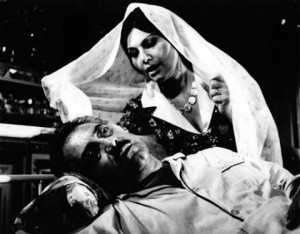
One element of the film which crucially contributes to the centrality of erotic charm and its association with feminine insubordination is the traditional song – “Maast, Kangar-Maast” –that we hear in the film on several occasions. Composed of basically nonsensical lyrics that definitely go lost in any translation, the song both starts the film and brings it to a close, providing a major musical motif of the film. On the very first occasion, it’s being hummed by Haji’s wife in a lustful manner that unequivocally acts as an invitation to bed. Although in this scene the wife presents herself to her husband in a way that resonates with the idea of fulfilling her domestic duty towards the head of the family and indulging his desire, it is not difficult to hear the notes of her own carnal feelings projected through her enticing deliverance. Next time the song is heard, its association with feminine expression is all the more amplified. It happens right after Haji Ala takes off to work. Now with the patriarch away, the family members – all female, with the exception of the young boy – break into dancing and signing to cherish their time of freedom. Here the lyrics, tweaked from the earlier version, directly mention Haji’s absence. By the third time it is performed, not only the association of the song with femininity has been established, it has also transcended into a jovial ode to triumph of female-hood. This time the song is reprised by the wife who, after being contemptuously expelled from the home, is called again to pay a visit to bed-ridden Haji Ala. Under the emotional ardour of putting up with the shame of giving his wife to an interim husband, as well as sex deprivation, Haji is experiencing a debilitating nervous meltdown. In this scene the camera presents her performance through Haji’s eyes, who in his delirious state forgets all about his previous deeds and religious rules and envisions his divorced wife apparelled in gossamer-thin, revealing clothing.[9] With Haji being shown earlier miserably regretting his hasty decision, this essentially feminine song implicitly celebrates the defeat of the swaggering patriarch who now is cognisant of his level of dependence on the “fairer sex.”
In this cinematic interpretation of the traditional theatre genre, it seems that the role of the black character – which often constituted the site of defiance – has been overtaken by females. Obviously the gender of the servant has changed into the female[10] and one can read a tendency for insurgency in the relation between the maid and Haji, finding expression in her collusion with his wife. The film also concludes with the maid’s image as she’s singing the abovementioned recurrent song, which by referring us back to its association with the femininity throughout the film, reiterates the unsung triumph of women achieved in unexpected ways in a society dominated by men. However the maid is not alone in this insubordination and one can perceive a sisterhood bond bringing together the female members of Haji’s household to collectively fill in for the black character. Thanks to this alliance, Haji finds himself being constantly disobliged after kicking out the wife. While the presence of his wife had given him a pretext to exercise his authority over the household, now with wife’s departure he’s literally divested of his power and proved ineffectual. Taken together with his deep sense of regret and hankering for his wife after being disabused, it shows to Haji who holds the true power.
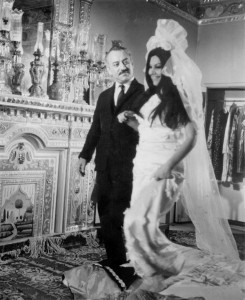
It’s important to note that despite carrying some characteristic features of a traditional man, Haji strikes a note of difference from the stereotypical image of these characters by displaying a genuine and undivided love for his wife. Apparently his love for his wife is so strong that it keeps him from the intrigue of getting a new wife – the central premise of The Triple Bed which I’ll expand on later – permissible and sanctioned by the same religious credo he’s abiding by. Instead, he’s depicted in the beginning of the film under the charm of his wife while reminiscing the pleasure of their wedding night. Unlike other men of the same mind-set who might seek the renewal of their sexual life by availing themselves of a new, yet legitimate partner, Haji is so overawed by his wife’s charm that instead in the opening sequence of the film he desires the re-enactment of their wedding night.
Such a strong bond between the couple once more can be credited to the wife’s gumption and her ability to keep herself still desirable to her man despite her advancing age. In point of fact, the love seems to be mutual and the wife seems to enjoy her matrimonial life by adapting herself to the general framework of traditional life and finding venues to assert herself and her desire within the permitted boundaries. She has learnt how to savour her life, while apparently internalised beliefs and values don’t allow her to transgress. Her loyalty is not simply induced by a fear of her jealous husband. Later in the film she plays an active part as a complicit to her husband in keeping the rival – who tricked all into accepting him as the interim husband by feigning impotency – at bay and unable to have his long withheld desire gratified.
While the film is often perceived as a criticism of defunct religious laws (sharia), it would be quite myopic to construe the film simply in such a limiting way, as the films fiercest detractors have tended to do. In the final analysis, the main character of the film is essentially bound by a set of traditional beliefs, underpinned by religion and sharia. That is to say, what puts the man in line with religion is his traditional roots which essentially define his lifestyle and beliefs. His adherence to religion is part of his dedication to traditional beliefs and the desperate status he has to suffer is in fact the result of a tremendous conflict he experiences on this occasion between sharia on one hand and the traditional concept of manhood and the unquestionable masculine honour on the other.[11]
Therefore, it is not religion per se that the filmmaker has a bone to pick with, but traditional beliefs which often establish their legitimacy by latching on to and entangling with the religious teachings. Such an alliance, as the story of the film shows, is oblivious of the loopholes that works against it. In this sense one can see a continuity of theme between The Interim Husband and The Triple Bed with the latter almost eschewing an explicit confrontation with religious laws, contenting itself instead with mocking traditions that border on superstitions. In both films Karimi showed a special interest in scrutinising the operation of traditions in a more intimate level. It is instructive to note that in The Interim Husband the final solution presents itself to Haji in form of a religious justification (counterpoising the hassle coming from the religion), therefore redeeming the main character from opting to go for an ungodly solution and a recourse to the civic laws. This guarantees his persistence in abiding by the rules of religion despite the inconvenience it caused him. A mirthful comedy as it is, The Interim Husband avoids coming to a didactic conclusion or going overboard in its critique for that matter; yet it shed some light as to how faith, through a process that involves sophistry and deliberate interpretations, underpins the traditional set of beliefs and helps it persevere.[12]
In each of Karimi’s films one often come across moments of exposition regarding either the traditional lifestyles or traditional architecture. In The Interim Husband and The Triple Bed, both of which are structured around a backward view of femininity originated from a parochially traditional viewpoint, the earliest parts of the films introduce and establish the main characters. This is mostly done in the form of a string of statements or reactions from the characters that offer solid examples of such mentality. Obviating any doubt as to the alignment of characters with a certain viewpoint, these lines and scenes come across collectively as an audio-visual catalogue of such traditions and behaviours. Yet they are also closely interweaved into the canvas of the story that steer the course of the events.[13] While in The Interim Husband Karimi more or less manages to keep the balance between comic and informative presentations of these traditions and beliefs, the comparatively more farcical set-up of The Triple Bed makes such scenes almost tip over into the terrain of parody.
Compared to Karimi’s prized debut, The Carriage Driver – another comedy of relationships with less emphasis on the affairs of the bedroom – the director’s tendency to further lean toward knockabout comedy in his later film is apparent, which teleologically can be seen as his departure from the stronger neorealist impulses of the first film towards a form of comedy generally perceived – and in the context of Iranian cinema, rightly so – as vulgar and lowbrow. In The Interim Husband even a dash of scatological gags is thrown in. Yet, aside from the general commonalities already discussed there are more specific parallels between The Interim Husband and its predecessor, such as the entangled love affair of couples belonging to two generations, a man’s rekindled feeling for a woman whose hand once he asked for and was denied, or even a riff on the circumcision gag from the earlier film (in The Interim Husband the subject of the gag is a Christian priest who is initially selected as a problem-solver, but then darts off in a wild run when learns about the requirement of bearing the mark of faith!). Despite sharing with Iranian commercial films a good deal of scenes and situations formed around physical and chaotic comedy, it has been argued that the realist aspect of The Interim Husband gives the film its distinction and becomes its saving grace by grounding them into the narrative. As such and unlike the typical approach in filmfarsi, these scenes of mayhem don’t appear to be sprinkled into the narrative haphazardly and with no narrative purpose (Tahaminezhad 1986: 59-60).
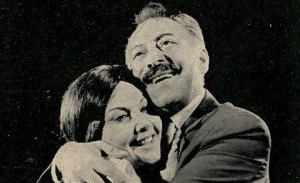
Karimi’s third feature (and comedy) is unmistakably the flip-side of The Interim Husband, similarly premised on a matrimonial triangle – if not a ménage a trois – featuring once again Karimi himself and Iren in the roles of the lead couple – but with the gender imbalance reversed and being of a less peculiar nature compared to the previous film. The early title of the script, Havoo – a term a married woman uses, somewhat disdainfully, in reference to her husband’s other wife – crystallises this reversal. Formulated this time around the relation between one man and two women – customarily treated as less striking than the opposite – the film is shorn of the subversive subtext of The Interim Husband and given its relatively inferior aesthetic quality considered a backward step for the filmmaker on all fronts. That said, it is still instructive to take a look at the film in the light of its predecessor and trace a more pronounced nod to commercialism that colours the content as well as aesthetics of the film.
The filmmaker’s point of focus in The Triple Bed is the status of the women with regards to their procreative capacity or lack thereof, which holds the key to taking up the reins of their traditionally defined as fundamental role of a mother. It deals with the stigmatisation of a barren woman – characteristic of a patriarchal ideology – that almost brings her to naught in the eyes of her husband’s family, who expect her to do her task for the continuation of his lineage. So it is the main female character of The Triple Bed who, unable to cope with an unremitting deluge of sarcastic words mainly coming from her mother-in-law, acquiesces to see her affable, yet indecisive husband marry a new wife. Almost immediately regretting her decision, she finds no option but to claim at least her due share of her husband. Hailing from a lower layer of society, the new family member, however, has her own ambitions which in essence is to take over the place of the lady of the house. Coupled with her uncouthness, this stirs friction and altercation in the household, eventually leading all extended family members including the man’s first wife into a strategic alliance against this lowly intruder. Finding herself rounded up on by enemies, the second wife’s response is to hatch up a deadly plot of revenge, but she is unprepared for the turns and twists of fate.
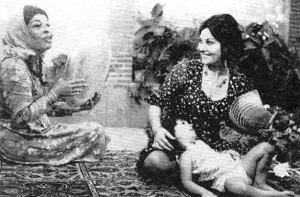
Karimi’s role here bears not many commonalities with the one in The Interim Husband save for his love for his wife – he is shown willing to forget about having a child and apparently it’s only through his mother’s cajoling and coercion that he relents to the proposal of remarriage. Conversely the female lead characters of the two films have much in common. Through Iren’s consummate performances – in roles with few similarities to her real self, as a member of the Armenian minority with a rather open-minded lifestyle[14] – plights of women in their different aspects are embodied. The main common denominator of Iren’s two roles is the sacrificial acts, committed in the interest of family. Whereas in The Interim Husband the faithful wife takes the fall to shield her daughter against her wrathful husband, in The Triple Bed she has to swallow her jaundiced feeling about sharing her husband with another woman, to keep everyone in the household content and happy.
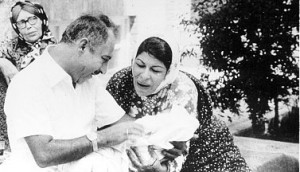
Notwithstanding its open critique of certain beliefs and obtuse superstitions, the overall position of the director towards traditions in The Triple Bed seems to be even more blunted in comparison to his earlier film. This can be imputed to the submission of the filmmaker to tropes of commercial cinema, being reworked here in a slightly different embodiment. As I mentioned earlier the whole premise of one man versus two women is by no means anything new in Iranian cinema of the time, even if they had not been laid simultaneously on the same bed (the triple bed of the title is literally present in one scene, though it ends up being an absurd solution that goes askew and before long is scrapped from the diegesis). The rivalry over a man between two women, one associated with innocence and modesty and the other representing a lifestyle of inequity, is as trite as other conventional tropes of filmfarsi, or even more so. With a twist on this hoary dyad, the film imagines a rare occasion in which two different incarnations of femininity – the lewd and the chaste woman – must live together under the same roof. All the same, the result is as conventional – and one would say, conservative – as other products of the commercial register of this national cinema. Like countless examples of a similar narrative, the outsider woman who has whipped up mayhem in the domestic space has to be done away with.
As far as the comedy is concerned, The Triple Bed similarly features a decline in taste, giving the impression that the filmmaker’s decision in his debut to refine the taste of his spectators without ignoring them has been jeopardised. Here it seems that it is the director who is following the average filmfarsi spectator’s tastes, inviting antics which brings the film to the neighbourhood of commercial cinema. One such example is the husband’s stunted brother, who has fathered a legion of children and has an insatiable appetite for sex, not to mention his tendency to take advantage of his small stature to hide and peep.
Speaking of which, the notion of voyeurism constitutes one of the interesting and curious themes of The Triple Bed. It had previously sprung up in Karimi’s filmography in a certain scene of The Interim Husband when Haji Ala, worried about what’s going to happen to his wife in her new husband’s neighbouring house, drills a hole into the house to literally keep an eye on his divorced wife. By connecting the two spaces and eventually putting the two rival men eye to eye while the woman is with one of them (even if refusing to submit), the scene functions almost as a visual euphemism for the idea of the triple bed literally depicted in the latter film, bringing all three sides of the triangle together in a sexually loaded context. Needless to say there’s all but sexual gratification in the scene, just as the scene with triple bed ends up in disaster. The presence of voyeurism in The Triple Bed is of a different nature insofar as it is obviously committed out of curiosity and urge for pleasure. The scenes of the film abounds with voyeuristic activities and almost no grown-up in the family’s house is spared from this tendency. The subject is of course the bed chamber of the newly-wed couple and even the elderly cannot hide their desire to feast their eyes by gawking inside. One might wonder if Karimi has intended to underscore the aberrant dimensions that sexuality can take in a traditional set-up. As a matter of fact the idea of a young couple being the subject of their parents’ voyeurism had already been deployed in The Carriage Driver, but in that earlier film it was mainly a pretext for the older man to start imitating his future son-in-law and frolic with his sweetheart. In The Triple Bed with elderly mother-in-laws peeping from behind the door, the voyeurism seems like a source of pleasure in itself for the characters.
The film itself might be considered as imbued with a degree of voyeurism especially in a certain scene set in a place traditionally cordoned off to the male spectators. It’s the female public bathhouse that finds its way into the film through the agency of the man’s new mother-in-law as a server in this place, who in this manner is also assigned to a lower social class. The scene stages a singing and dancing set-piece which might elicit comparison with the the signing scene in the absence of Haji in The Interim Husband inasmuch as both feature a feminine space in which women can celebrate their moment of freedom and release their pent-up voice (the wife in The Interim Husband has to distort her voice when talking to a stranger from behind the door). The male busybodies are only present as small boys who have to follow the feminine order at the pain of punishment (noticing a young boy behaving like an inchoate peeping tom, the new mother-in-law rubs some eye-searing soap over his face). This space of sisterhood is the place for the ulterior feminine deals to be hammered out unbeknownst to the men. It is in this scene that the man’s mother proceeds with her plans to find a new wife – a fertility machine, in truth – for her son who seems to be totally left in the dark. In fact there’s no scene showing the matter being discussed with him and the propostion in the bathhouse is immediately followed by the actual wedding ceremony. The scene, in fact, delivers on the promise of serving the audience with the required dose of singing and dancing – and a fair amount of skin – according to the unwritten rules of commercial Iranian cinema of the time. It might be worth noting that unlike the conventional song and dance scenes taking place in a cabaret, in this scene there’s no male character present to vicariously represent the male spectator of the film.
The role of the the second wife who performs for the all-female audience – and yet for the male spectators inside the theatre – is played by no one other than Shahrzad, an actress almost ossified in the role of a dancer and often a distraction from the true love interest, despite the fact that a good number of films she appeared in are helmed by the New Wave directors. A riff on the same stereotype, her role here seems to be coloured with her social background that held potential for some character depth. She apparently belongs to a lower social class and her actions can be seen as a reaction to the contempt with which she was received, specially by the traditional layers that would find her rather racy and indecorous in her behaviour. In a rare moment in the film when she finds herself alone against every member of her husband’s family, she might even elicit the sympathy of the spectator. However such potential has been wasted and counterpoised by her being portrayed as an almost heartless and unfeeling woman with almost no affection or care about the girl she begot from an earlier marriage. Due to the filmmaker’s adherence to the codes of bifurcated femininity, she appears in the final analysis as a female monster, a dehumanised femme fatale who, in ways not dissimilar from Glenn Close’s character in Fatal Attraction (1987), threatens the unity of a family – even if her entry into the story has been of a totally different nature – and so the only way to restore the order is her extermination. Both The Interim Husband and The Triple Bed end with the initial bond between the main couple restored, while in the latter film even their main challenge is solved by the adoption of the second wife’s neglected child. Significantly the child that brings stability back to the household doesn’t carry the man’s blood, whereas the second wife takes with her to the grave the child she’s begotten with him. Through such an arrangement any trace of this episode that could potentially revive memories and perturb the bliss of the family in the future is wiped off. Similarly, in The Interim Husband no intercourse whatsoever takes place between the woman and the interim husband – thanks to the wife’s consummate fidelity – which otherwise could have left an inimical effect on her relation with her husband, almost making her return impossible.
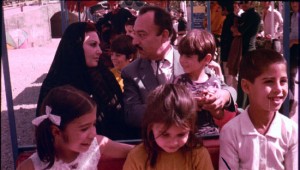
That said, it’s interesting to notice that both films in the course of their running time gradually drive us to side with characters initially introduced as deplorable, to say the least. Bound up in a reprehensible tradition, they bring a lot of hassle to the life of their closest ones. Nonetheless, the misery visited upon them due to them narrow-mindedly observing their antiquated beliefs somehow brings the audience to be forgiving of their idiocy. Doubtless the genre of the films – comedy – has a role in such a change of heart. In finding The Triple Bed more conservative compared to The Interim Husband, the gender of the character representing the traditionalism might also have a part. Unlike The Interim Husband, in which a critique of gender politics and patriarchal principles runs in parallel with criticising the traditions, in The Triple Bed the traditions are embodied and pursued by the female characters, acting almost as half-witted creatures, just as men in a patriarchal society tended to view and treat them. On the other hand, the main male character of the film is pictured as somehow open-minded and simply lacking resolve to face up to the female characters who dominate his life. Even in the first scene of the film, he is pictured being washed in the bathroom by his wife. The same image is repeated at the end of the film, but now it is the adopted child who’s being washed by the couple. Such a parallel in this circular structure reaffirms the restoration of peace and the compensation of lack; yet the opening scene also confers a sort of infantile quality upon the undetermined husband and prefigures his indecision. It is by his heroic act of rushing to save the child that the husband finally hoists himself up to the level of a parent, on a par with his wife.[15] A parody of masculinity can also be found in character of the dwarfish, ever-horny brother. But all in all, in presenting the women both as strong and gullible, the ambiguous position of the film – which doesn’t necessarily echo that of the filmmaker – makes itself known.
No discussion of femininity in The Triple Bed would be complete without mentioning the scene in gynaecologist’s office. It is one of those noteworthy moments when the director captures the interiority of a woman raised with and accustomed to traditional views about her relation to strange men. In the scene in question, the husband – obviously overcoming the traditional jealous feeling of his counterpart in The Interim Husband – takes his wife to be examined by a male gynaecologist. More so than the husband, we find the wife distraught, specially after realising that her husband is not allowed to accompany her into the examination room. In this scene the filmmaker successfully conveys the sense of unease experienced by a woman who is all the time instructed to be modest and offer her body only to her husband and now she has to expose her genitalia to the scrutiny of a male gaze, even if a scientific one. With this scene, Karimi once again presents himself as the master of exposing typically undiscussable fears and shames, as with the whole “interim husband” affair.

The Triple Bed almost remains Karimi’s last examination of the intimate corners of the traditional Iranian lifestyle. With his next and final film before the revolution, Ruined, he directed his enquiring humour towards social problems. Despite the presence of certain general thematic trademarks of the director, the focus of the film shifted away from the matrimonial aspects of a household onto the physical transformation of the urban landscape and its effect on the family lifestyle. It stands to reason that even if the unofficial ban from making live action features hadn’t been enforced against Karimi by the Islamic regime, it was impossible for him to direct his camera into areas strictly considered as off limits under the prudishly restrictive filmmaking regulations of the new government. The candour that underscores Karimi’s films and is propounded by them was the polar opposite of the official view of the Islamic regime when it comes to household affairs.[16] With their affinities with Italian neorealism, while trying to be a local incarnation of it, Karimi’s comedies, in the eyes of today’s viewer, present what has been sorely absent from Iranian cinema, despite all discussions surrounding it within international scholarship and criticism, and – in my view – the ungainly attempts made by Iranian filmmakers to offer slice-of-life images of the domestic sphere. Made free from every manner of restriction imposed on today’s Iranian filmmakers and despite being tarred to varying degrees by the brush of commercialism, Karimi’s films reveal effortlessly how tenuous, if not sheerly preposterous, would be any claim to realism in the true sense of the word in the context of post-revolutionary Iranian cinema.
Ramin S. Khanjani obtained his Master’s degree in Film Studies from Carleton University, Ottawa. His writings and reports have previously appeared in the Iranian publications, Film Monthly and Film International. He is the author of Animating Eroded Landscape: The Cinema of Ali Hatami (2014).
References
Ahmadi, Hamed (2015), “Zendegi-e Bashokooh-e Agha-ye Karimi” (“The Illustrious Life of Mr. Karimi”), Rooz Online, 24 December.
Ansari, Mohammad Bagher (2008), Namayeshe-e Roo-Howzi: Zamineh, Zamaneh va Anasor-e Khande-saaz (“Roo-Howzi: The Background, Era and Comic Elements”), Tehran: Soore-ye Mehr.
Mehrabi, Masoud (1987), Tarikh-e Sinama-ye Iran (“History of Iranian Cinema”), Tehran: Film Magazine Publication.
Naficy, Hamid (2011), A Social History of Iranian Cinema: Volume 2, Durham: Duke University Press.
Omid, Jamal (1998), Tarikh-e Sinama-ye Iran (“History of Iranian Cinema”), Tehran: Rozaneh.
Tahaminezhad, Mohammad (1986), Sinama-ye Royapardaz-e Iran (“Iranian Cinema of Escapism”), Tehran: Aks-e Moaser.
Zhirafar, Ahmad (2013), Tarikhche-ye Kamele Dooble be Farsi Dar Iran: Jeld-e Avval (“A Complete History of Farsi Dubbing in Iran: Volume 1”), Tehran: Ketab-e Koole-poshti.
[1] This excludes the short films he made as a pioneering animator before delving into live-action filmmaking, which merit a full study of their own.
[2] Before making The Carriage Driver Karimi began shooting another comedy, The Thief and the Cop (1970). Due to conflicts with the producer, however, he left the project, and the film was completed by Mahmoud Kooshan, who received sole director’s credit.
[3] Together with the erotic and boldly explicit drama, Speeding Naked till High Noon (Berehne ta zohr ba sor’at, 1976, directed by Khosrow Haritash), Karimi’s film continues to be brought up as a strong case against Mehdi Missaghieh, a juggernaut producer of pre-revolution cinema, to indict him – a follower of Baha’i faith – as a complicit and a major contributor to a “decadent” culture formed under the auspices of the royal regime.
[4] In interviews, Karimi himself emphasised the commonalties between his first three films, while trying to deflect the notion that his directorial career has gone downhill and asking the critics to save such general statement for the time his filmmaking output has been duly expanded (see Omid 1998: 610).
[5] As noted by Hamid Naficy (2011: 350).
[6] Karimi was an active member of the Iranian theatre community in the 1950s, before his sojourn in Czechoslovakia and Italy. Yet, he was also involved in performing in plays written by foreign writers.
[7] Karimi’s fascination with neo-realism goes back to his student days in Czechoslovakia.
[8] Though there are other translations for this term, I guess The Interim Husband – originally chosen by Hamid Naficy in his book on Iranian cinema – clearly puts across the central point of the film as well as the tradition, particularly to those who don’t know a thing about it.
[9] Brief dream scenes make an appearance in almost all of Karimi’s feature films.
[10] In his book, Theatre in Iran, Bahram Beizai indicated the use of female servant characters in Roo-Howzi theatres, who might be black as well. But it’s the male black servant who is almost the trademark of these theatres.
[11] From a different angle, masculine honour had already been the subject of Karimi’s seething humour in The Carriage Driver, where it is investigated through the mother and son relationship and the agony and distress the young man experiences in envisaging his widowed mother getting married to a new guy. This places the film next to Ali Hatami’s Ghalandar (1972) which was inspired by another form of a masculine jealousy operating within a traditional family (a brother’s concerns about his sister).
[12] One brief scene in The Carriage Driver might foreshadow Karimi’s interest in weaving a humorous yarn around the religious laws governing marriage. In this scene, the protagonist asks a notary about sharia’s stand vis-à-vis the relationship he’s aiming for (marrying a woman whose son will be his future son-in-law). In this case, sharia seems to be posing the least of obstacles, as the notary reassures him that the marriage will be religiously legitimate. Once again, the main obstacles are rooted in cultural traditions.
[13] Due to this almost obsessive presentation, one might feel that some sections of Karimi’s films are stretched beyond their dramatic function. This protraction stands as one of the major criticisms of The Carriage Driver in one review which overall had a positive estimation of the film (see Omid 1998: 583).
[15] Karimi formulated the ending of The Triple Bed almost in the same fashion as The Carriage Driver by coupling a deadly plot of revenge with the following cliffhanger of saving a life. In both films, the protagonist must prove himself worthy of what he aspires to be (a dad or a husband) by risking his life to save the one who want to bring fulfillment to their lives (the protagonist’s beloved in The Carriage Driver and the child in The Triple Bed).
[16] In one video interview recorded in 2000 Karimi revealed an interest in tackling things which was generally seen as awkward to discuss. He seemingly followed the same conceit in a puppet TV series, Voroojak (“The unruly kid”) directed by him for a private TV station.
